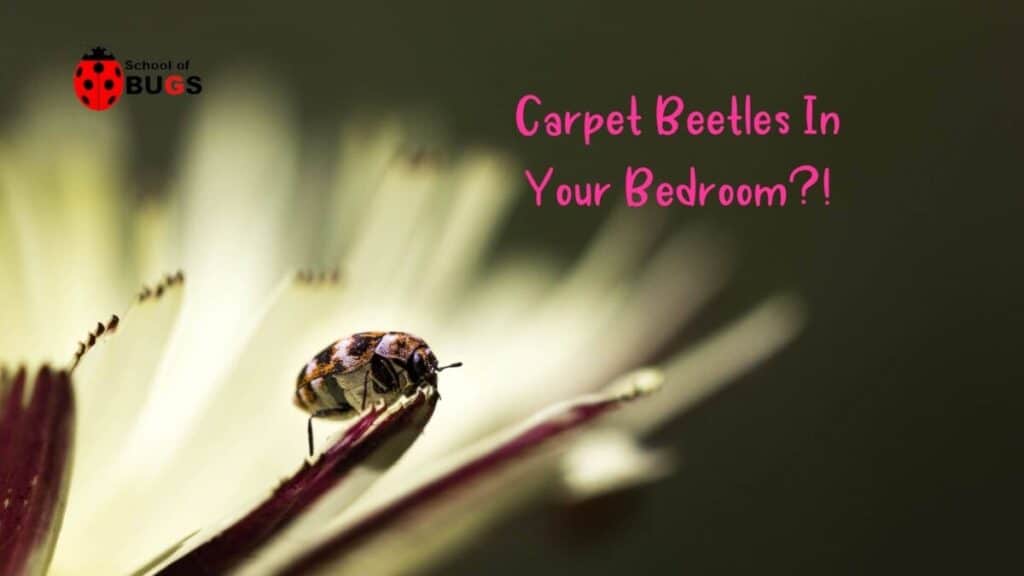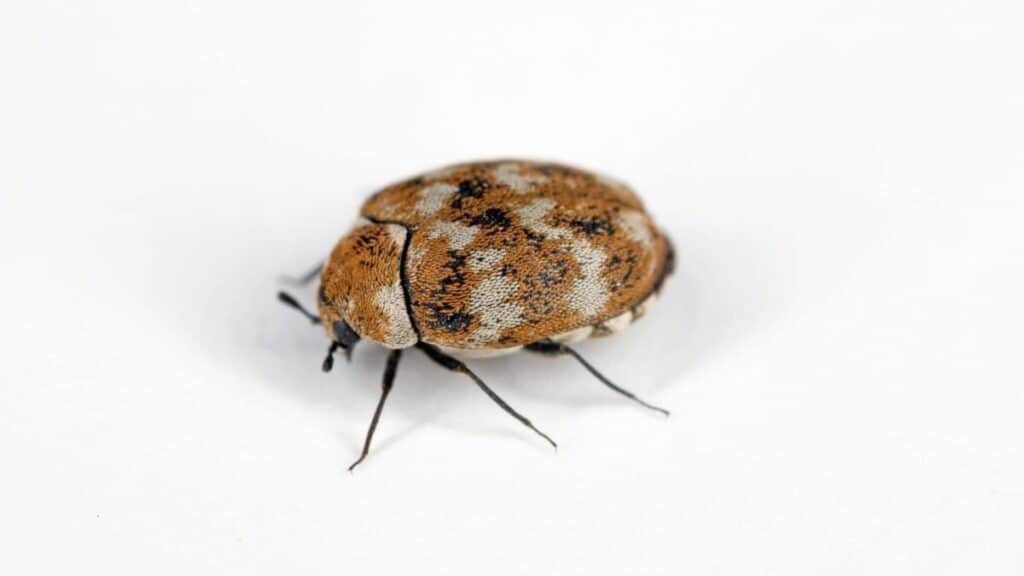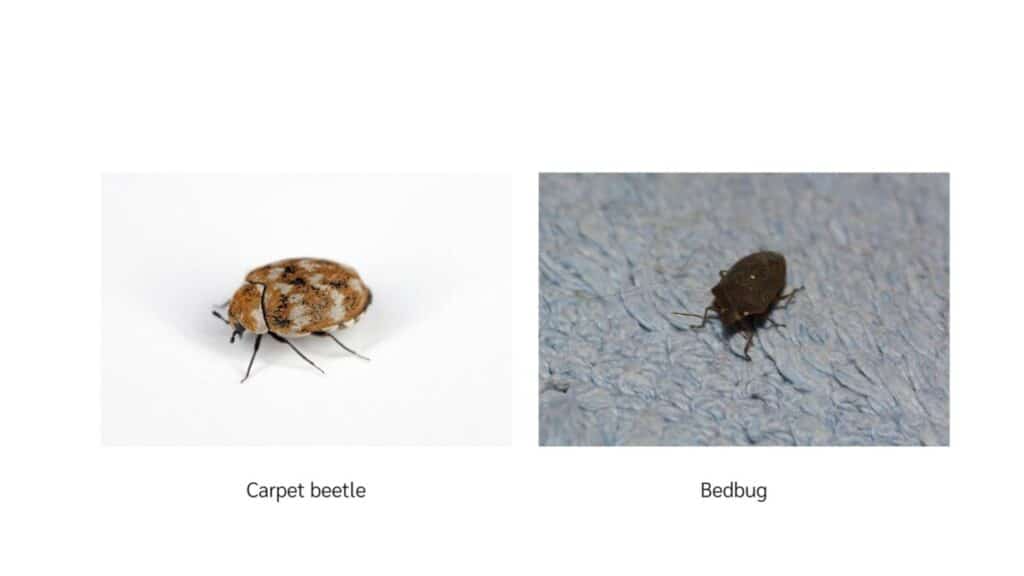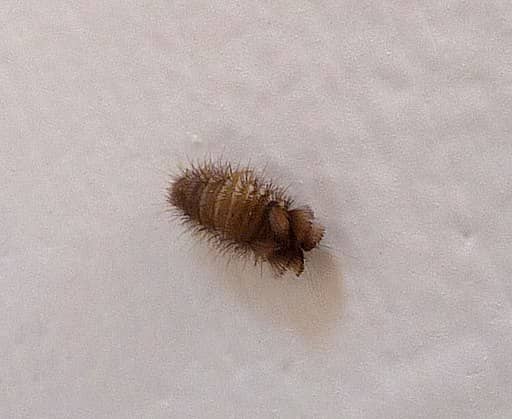
As we have discussed elsewhere in this series, there are several beetles that could inhabit homes and in a number of cases, an infestation in and around the bedroom can be mistaken for a bed bug attack.
We will discuss another such beetle – the carpet beetle also called the varied carpet beetle (Anthrenus verbasci) – that is often mistaken for the bed bug. There are, however, some key differences.
Carpet Beetles look Amazingly Like Bed Bugs
Many of the other candidates for the bedroom – such as red flour beetles, larder beetles, or spider beetles – are small, ranging from 1/8 to 3/8 inches in length for an adult.
The carpet beetle is at the smaller end of this spectrum, that is, about 1/8 inches.

What’s different, however, is how they look. The other beetles are red to brownish-red in color for the next part.
If you get right down to it, some also look distinctly different than a bed bug – for example, the spider beetle does somewhat resemble a tiny spider.
The adult carpet beetle, on the other hand, looks very close to a bed bug. They are oval, almost spherical, in shape, dark brown tending to black in color.
They have a pair of wings and antennae in addition to three pairs of legs and bulging eyes. They do tend to have orange and red stripes across their back, which could distinguish them if viewed closely.

Carpet Beetles Prefer the Outdoors
Another distinction between bed bugs and carpet beetles is that the former sup on human blood, therefore they stay in homes by necessity.
Carpet beetles, on the other hand, usually prefer nesting outdoors. They are drawn indoors to nest and lay eggs, often coming in through gaps in the foundation, through windows and doors, or carried in on plants or flowers.
Being strong fliers, they can quickly spread inside the house. This may accelerate during cold weather, when they prefer to live in the warmth and comfort of your home.
The Larvae of the Carpet Beetle Create the Most Problems in the Bedroom
As far as humans are concerned, the problems from a carpet beetle infestation in the bedroom will come from the larvae.
The larvae are typically dark brown tending to black, oblong in shape and covered with bristly setae. They are often called “woolly bears” due to their appearance.

The stiff hairs create skin reactions on sleeping humans and lead to rashes that could be mistaken for bed bug bites. The welts can be numerous, and blood stricken, in the worst cases.
What Do Carpet Beetles Eat?
As mentioned above, carpet beetles thrive outside the house. They will often live in abandoned bird nests or animal lairs, feeding on dead insects, nectar, and pollen.
However, if and when they come inside the house – whether, in search of food, warmth, shelter, or all three, they can be extremely destructive.
That is where they get their names from since both the adult and the larvae tend to attack carpets, upholstery, and fabric in search of food.
How do Carpet Beetles End Up in the Bedroom?
Carpet beetles can feed on costly household material, including furs, carpets, upholstery, linens, and curtains – which is how they end up in living areas and human bedrooms.
The larvae of carpet beetles are responsible for most of the damage done around the bedroom.
Their diet consists principally of the keratin and chitlin of natural fibers, such as animal hairs, feathers, and dead insects, but they will go after carpets, fabrics, linens, and furnishings with a gusto. They are even more voracious than the adults.
Where You Will Find Carpet Beetles Inside?

Carpet beetles are attracted to the bedroom due to the possibility of devouring animal-based products, which could come from the humans themselves (think of hair, flecks of skin, etc.), or from edibles that are kept close by the bed. But once there, they will gladly feed on the fabric all around the room.
Once they get into the bedroom and living areas, carpet beetles can make themselves comfortable in many spots.
They do not live in the mattress, as bed bugs do, but they can survive under carpets, under the bed itself, in upholstery, and in other spots.
Carpet beetles are attracted by the carbon dioxide emitted by humans. Plus, they venture inside for the purpose of nesting and laying eggs, so the warmth and moisture in bedrooms become prime venues for them to live and propagate – which they will do vigorously like other beetle species (learn more).
No Biting, but Bad Effects Nonetheless
Carpet beetles do not bite, a trait they share with many of the other storage pest beetles (see the list here).
However, the heavy cilia on the larvae – which will start appearing in multitudes extremely soon after the adults venture in – cause skin rashes as they forage for food in your bed. Plus, the hair can be inhaled and can cause lung irritations if inhaled.
In addition to the effects on your person, the voracious larvae can do substantial damage to the linens and fabrics around the bedroom, including the carpet and upholstery.
Controlling Carpet Beetles
The general principles regarding how to control beetle infestations in your bedroom and home (full article here) apply to carpet beetles as well.
If you show regular signs of rashes or breathing difficulties, it is definitely time to consult a professional, since the problem is likely to multiply with every passing week and month.
Alright, that’s it for this article, here are a few hand-selected articles that you might also find interesting reads:
The Wonderful World of BeetlesAre Drugstore Beetles Harmful (Quick Facts)
What Bug has Black and White Stripes? Answered
Recent Posts
Tiny Black Bugs in Bathroom NO WINGS: What They Are and What to Do!
Finding tiny black bugs in your bathroom can be uncomfortable, to say the least. Especially if they are persistent, or they appear in very large numbers, which they often like to do. When it...
Tiny Black Bugs in Plant Soil - What Are They & What To Do About It
A short horror story: You get a new houseplant. You do your best to take care of it. You’ve ensured that it has the right soil, the right amount of sun, it gets enough water. And then one day, you...

